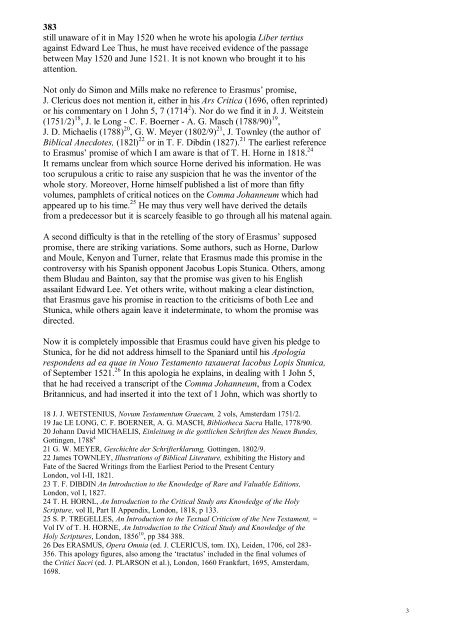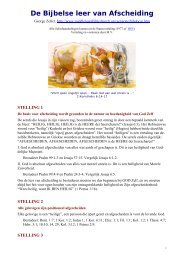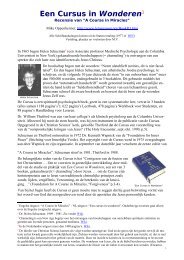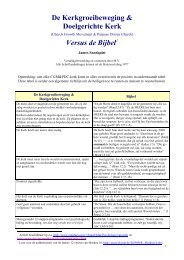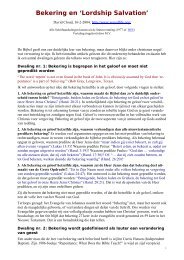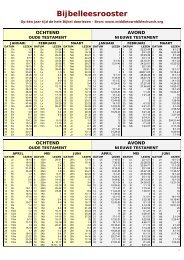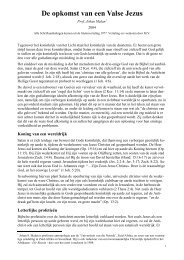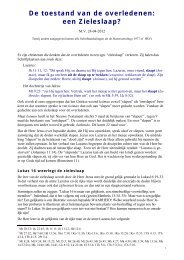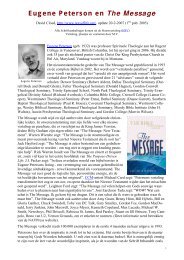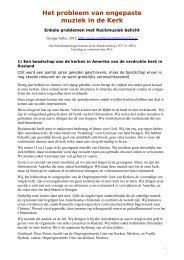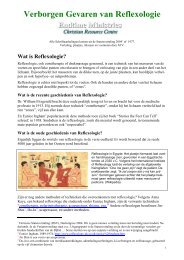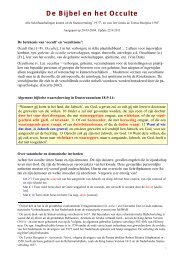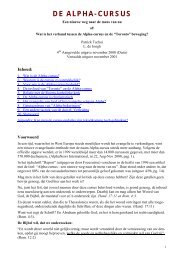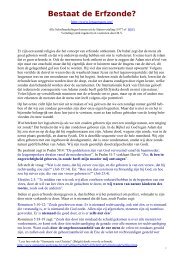erasmus and the comma johanneum - Marc Verhoeven
erasmus and the comma johanneum - Marc Verhoeven
erasmus and the comma johanneum - Marc Verhoeven
Create successful ePaper yourself
Turn your PDF publications into a flip-book with our unique Google optimized e-Paper software.
383<br />
still unaware of it in May 1520 when he wrote his apologia Liber tertius<br />
against Edward Lee Thus, he must have received evidence of <strong>the</strong> passage<br />
between May 1520 <strong>and</strong> June 1521. It is not known who brought it to his<br />
attention.<br />
Not only do Simon <strong>and</strong> Mills make no reference to Erasmus’ promise,<br />
J. Clericus does not mention it, ei<strong>the</strong>r in his Ars Critica (1696, often reprinted)<br />
or his commentary on 1 John 5, 7 (1714 2 ). Nor do we find it in J. J. Weitstein<br />
(1751/2) 18 , J. le Long - C. F. Boerner - A. G. Masch (1788/90) 19 ,<br />
J. D. Michaelis (1788) 20 , G. W. Meyer (1802/9) 21 , J. Townley (<strong>the</strong> author of<br />
Biblical Anecdotes, (182l) 22 or in T. F. Dibdin (1827). 21 The earliest reference<br />
to Erasmus’ promise of which I am aware is that of T. H. Horne in 1818. 24<br />
It remams unclear from which source Horne derived his information. He was<br />
too scrupulous a critic to raise any suspicion that he was <strong>the</strong> inventor of <strong>the</strong><br />
whole story. Moreover, Horne himself published a list of more than fifty<br />
volumes, pamphlets of critical notices on <strong>the</strong> Comma Johanneum which had<br />
appeared up to his time. 25 He may thus very well have derived <strong>the</strong> details<br />
from a predecessor but it is scarcely feasible to go through all his matenal again.<br />
A second difficulty is that in <strong>the</strong> retelling of <strong>the</strong> story of Erasmus’ supposed<br />
promise, <strong>the</strong>re are striking variations. Some authors, such as Horne, Darlow<br />
<strong>and</strong> Moule, Kenyon <strong>and</strong> Turner, relate that Erasmus made this promise in <strong>the</strong><br />
controversy with his Spanish opponent Jacobus Lopis Stunica. O<strong>the</strong>rs, among<br />
<strong>the</strong>m Bludau <strong>and</strong> Bainton, say that <strong>the</strong> promise was given to his English<br />
assailant Edward Lee. Yet o<strong>the</strong>rs write, without making a clear distinction,<br />
that Erasmus gave his promise in reaction to <strong>the</strong> criticisms of both Lee <strong>and</strong><br />
Stunica, while o<strong>the</strong>rs again leave it indeterminate, to whom <strong>the</strong> promise was<br />
directed.<br />
Now it is completely impossible that Erasmus could have given his pledge to<br />
Stunica, for he did not address himsell to <strong>the</strong> Spaniard until his Apologia<br />
respondens ad ea quae in Nouo Testamento taxauerat Iacobus Lopis Stunica,<br />
of September 1521. 26 In this apologia he explains, in dealing with 1 John 5,<br />
that he had received a transcript of <strong>the</strong> Comma Johanneum, from a Codex<br />
Britannicus, <strong>and</strong> had inserted it into <strong>the</strong> text of 1 John, which was shortly to<br />
18 J. J. WETSTENIUS, Novum Testamentum Graecum, 2 vols, Amsterdam 1751/2.<br />
19 Jac LE LONG, C. F. BOERNER, A. G. MASCH, Biblio<strong>the</strong>ca Sacra Halle, 1778/90.<br />
20 Johann David MICHAELIS, Einleitung in die gottlichen Schriften des Neuen Bundes,<br />
Gottingen, 1788 4<br />
21 G. W. MEYER, Geschichte der Schrifterklarung, Gottingen, 1802/9.<br />
22 James TOWNLEY, Illustrations of Biblical Literature, exhibiting <strong>the</strong> History <strong>and</strong><br />
Fate of <strong>the</strong> Sacred Writings from <strong>the</strong> Earliest Period to <strong>the</strong> Present Century<br />
London, vol I-II, 1821.<br />
23 T. F. DIBDIN An Introduction to <strong>the</strong> Knowledge of Rare <strong>and</strong> Valuable Editions,<br />
London, vol I, 1827.<br />
24 T. H. HORNL, An Introduction to <strong>the</strong> Critical Study ans Knowledge of <strong>the</strong> Holy<br />
Scripture, vol II, Part II Appendix, London, 1818, p 133.<br />
25 S. P. TREGELLES, An Introduction to <strong>the</strong> Textual Criticism of <strong>the</strong> New Testament, =<br />
Vol IV of T. H. HORNE, An Introduction to <strong>the</strong> Critical Study <strong>and</strong> Knowledge of <strong>the</strong><br />
Holy Scriptures, London, 1856 10 , pp 384 388.<br />
26 Des ERASMUS, Opera Omnia (ed. J. CLERICUS, tom. IX), Leiden, 1706, col 283-<br />
356. This apology figures, also among <strong>the</strong> ‘tractatus’ included in <strong>the</strong> final volumes of<br />
<strong>the</strong> Critici Sacri (ed. J. PLARSON et al.), London, 1660 Frankfurt, 1695, Amsterdam,<br />
1698.<br />
3


